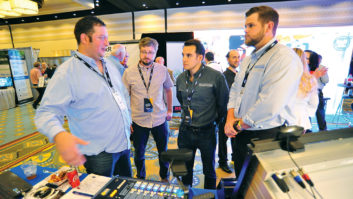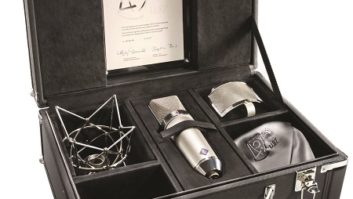
Radio broadcast engineering was easy when I started full-time back in the 1960s. Everything was analog, and audio transformers were real problem-solvers when it came to hum from ground loops.
Then came active balanced circuits, which did not have audio artifacts created by iron-core audio transformers. That change cleaned up audio a bit, but it was all still analog. There was no such thing as digital anything back then!
The big problems in that era were cartridge tape machines that needed constant maintenance to keep the tape heads clean. Tape head alignment was important to keep high-frequency audio response as good as the mechanics could allow for moving magnetic tape through a machine. Advances on how to do that were the stuff of NAB presentations, with each manufacturer trying to outdo the others.
Reel-to-reel tape machines had similar problems. It was analog technology. All of that went by the wayside when storing audio moved over to digital in the 1980s.
Now we are converting analog studios with digital audio storage into fully digital studios. Stations have one by one converted and haven’t looked back.
I asked a couple of my industry colleagues to share their reflections about “A” and “D.”
“Just mouse clicks”

Contract engineer Jim Offerdahl of Offerdahl Broadcast Service in Fosston, Minn., told me, “I grew up in a world with analog telephones, radios and televisions. My earliest experiences in radio broadcast facilities were analog. As time marched on, more and more equipment became digital. First it was satellite receivers, then audio storage.”
Offerdahl says there are many analog-only facilities still being used, and he’ll continue to maintain them as long as they are serving their users.
“New facilities today are a mix of analog and digital. A client that is only adding a small studio for production or is replacing an analog console usually remains analog. A client that is doing a total redo from top to bottom will likely build an all-digital facility.”
He remembers working with wiring earlier in his career. “Cables were either cloth- or lead-wrapped. I recently rebuilt a transmitter facility that was constructed in the 1930s. The original wiring was a mix of both. Wire lacing was an art back then using waxed string.”
[“The Real World of AoIP,” a Radio World ebook]
When Offerdahl entered the business a couple of decades ago, the standard was to terminate wires in each studio on either terminal strips or punch blocks. “I rebuilt several facilities that were all-analog using punch blocks with cross connects,” he recalls.
“Then in the late 2000s, I helped complete a build utilizing an AES3 audio distribution system that was a hybrid analog/digital facility. That told me digital audio distribution was the next big thing.”
As the years progressed, he constructed more digital facilities.
“Recently I embraced the StudioHub standard of wiring using Cat-5 cables and StudioHub adapters. I now wonder why I was not doing that earlier.
“Even more recently I constructed some new all-digital facilities using Livewire AoIP architecture. No more punch blocks, just patch panels with Keystone jacks. No more cross connects, just mouse clicks.”
Offerdahl suspects that for as long as he is in the industry there will still be analog work to do. “But more and more of it is moving to the digital world.”
“I think it is obvious”
Doug Thompson is a contract engineer with Intellitech Engineering Services in Osceola, Wis.
“If I were asked to build an analog studio today, I would have to recommend the client reconsider that decision,” he said.
“Analog certainly presents some apparent advantages over digital, especially if the client is familiar and comfortable with analog equipment. They may have a station that uses many types of analog equipment (consoles, switchers, distribution amplifiers and such) and may not want to change what they have invested many hours in learning how to operate and maintain.

“But if they would stop and consider how much of their plant is already ‘digital,’ it may actually surprise them. The satellite receiver, possibly their STL link, their telephone system, then certainly the internet and automation systems are all digital now.”
He notes that digital systems are efficient to install and operate, and can offer greater flexibility.
“I installed an analog system into two studios a few years ago. The client wanted to re-use their consoles, distribution amplifiers and switchers. It made sense to them not to buy new equipment to replace what they already had that was still serviceable,” he said.
“Well, it took me about three weeks to lay out, design the wiring charts, install and wire the many equipment connectors, work the RF out of the system — there was a co-located AM transmitter — and test everything. I even had the help of another engineer for a week of that time.”
The system worked well and sounded good afterward, he said; the client was happy with the result.
“A few weeks later they asked if I could add some inputs to the automation system. I did so, which required modifying the wiring charts, pulling a few more pairs of wire, adding connectors and setting the levels. It all worked fine and only took me about eight hours of work. A few weeks later they wanted me to add another satellite receiver. Same process and it took maybe 6 hours this time.”
Two months later, Thompson was hired by another station to replace a talk studio by installing a digital IP-based system.
“Another engineer and I began at 5 p.m. on Friday tearing out the furniture, carpet and wall covering. New carpet and furniture were installed. We wired the IP-based console and peripheral equipment including microphones with arms, headphone amplifiers, PCs and installed an IP-based phone system.”
They had the system operating by 3 p.m. on Sunday by working 10-hour days.
“We did take a few hours beforehand to prep the digital system software. The project worked. Later, when asked to add another source to a console, it took about 15 minutes via the PC-based tools provided by the manufacturer of the system.”
He notes that the digital option cost more up front. “But the labor costs for the installation and ongoing changes, which always happen, were far less than the analog.”
Also, some changes and upgrades can be done on a digital system from off-site, which came in handy during recent COVID shutdowns.
“I think it is obvious why I would recommend a digital system over analog today,” Thompsons aid. “It is less costly overall, as well as being easier to maintain and upgrade.
“Digital is very flexible because there are far more features for the operators that are usually built right into the base product. It can be operated remotely for voice tracking from home, allows single operator broadcasting from sporting events or remotes and integrates well with other related systems such as automation, phones and the internet.”
Sure, he said, the users must learn a new system; but the consoles look and work a lot like the old analog consoles, plus they offer many nice features to make things simpler for the user. “In addition, digital systems are much easier to maintain and expand, certainly from my perspective.”
Thompson said he doesn’t expect to build any more analog studios in the future — unless, he said, he decides to volunteer at a broadcasting museum.
Mark Persons, WØMH, is a Life Member of the Society of Broadcast Engineers, and one of only 10 people to receive its John H. Battison Award for Lifetime Achievement.
What do you see as the major benefits of “working with digital”? Write to [email protected] with “Letter to the Editor” in the subject field.









